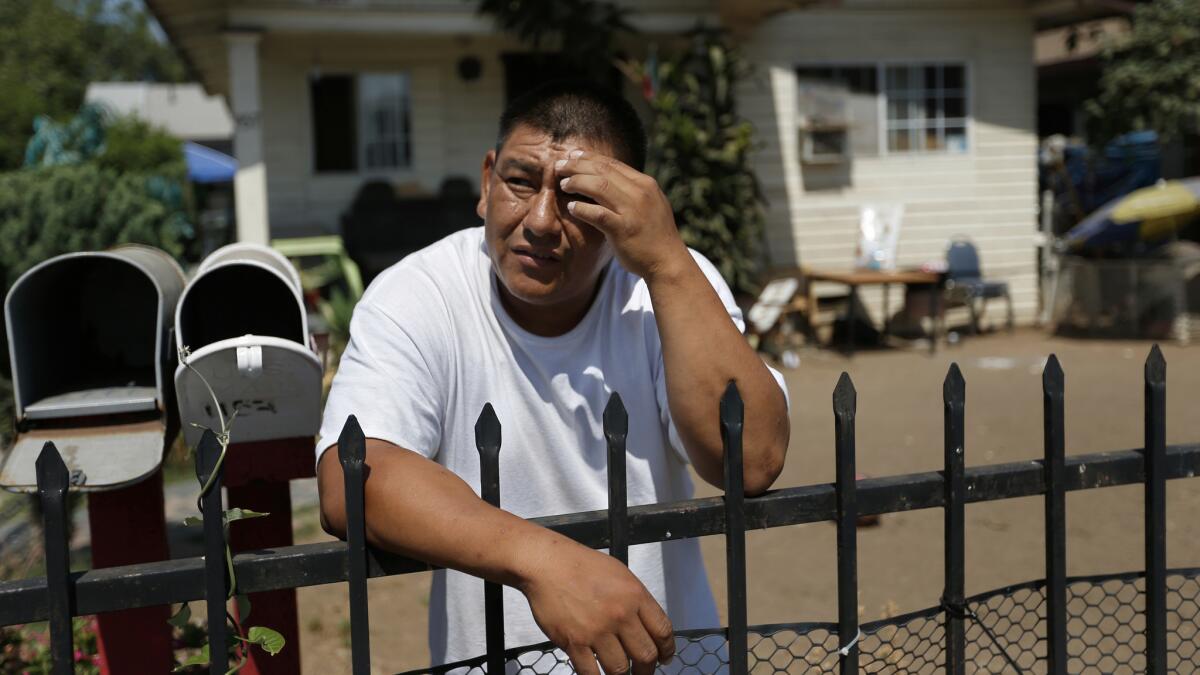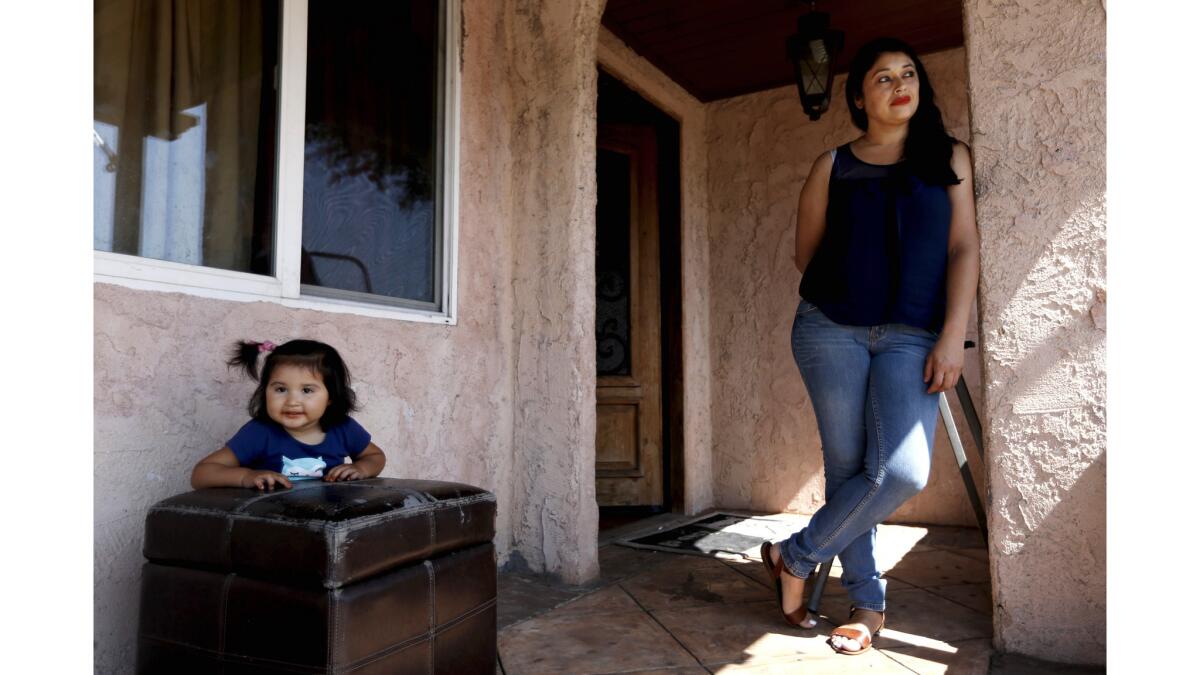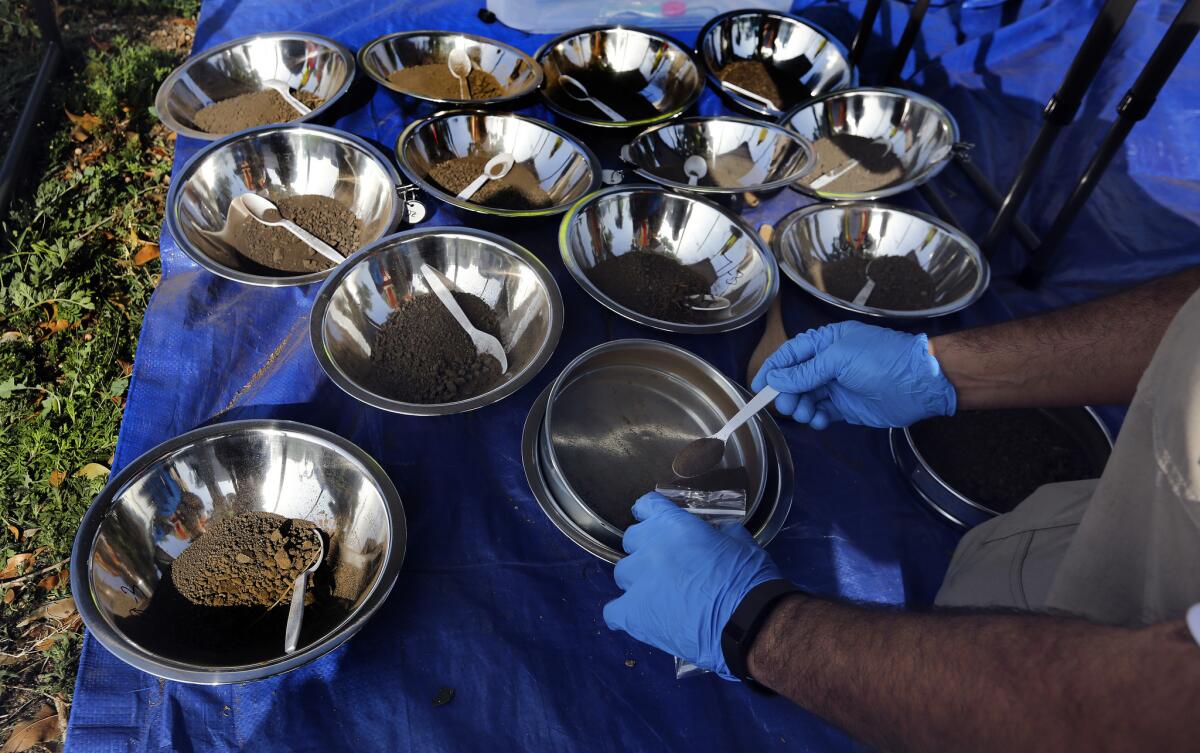Brain-damaging lead levels near battery plant found as high as 100 times above health limits

Homes, schools and at least one day-care center near a shuttered Vernon battery recycler are contaminated with higher levels of brain-damaging lead than previously disclosed, with soil samples at one property as much as 100 times above California’s health standard, state and county records show.
Yet it remains unclear where and at what concentrations the poisonous metal has been detected in neighborhoods near the Exide Technologies plant because state regulators have failed to release pollution readings for the vast majority of properties.
The California Department of Toxic Substances Control says it has tested the soil of more than 2,400 homes, but provided readings for just 269 properties.
A summary of results for 1,190 homes released Friday by the department was not broken down by property or location, but indicated thousands of soil samples were above state health standards and hundreds were at hazardous waste levels.
While the department says it informs individual residents of their test results within two months, the lack of disclosure of sampling data prevents the affected communities and the public from gauging the state’s overall progress in finding and removing lead-contaminated soil across seven southeast L.A. communities, the largest such effort conducted in California.
For three decades, state regulators allowed the plant about five miles from downtown L.A. to operate without a full permit while it racked up environmental violations for spewing lead, arsenic and other dangerous pollutants. They now believe those emissions fouled as many as 10,000 homes within a 1.7-mile radius.
Lead is a powerful neurotoxin that poses the greatest risks to children under younger than age 6. Even small amounts can lower IQs, reduce academic achievement and cause other permanent developmental and behavioral problems.
An analysis by state health officials in April found that children living near the facility had higher levels of lead in their blood than those living farther away.
We are concerned, but what can you do? We are just waiting.
— Yolanda Soto, East Los Angeles resident

The U.S. Environmental Protection Agency considers a soil level of 400 parts per million or higher a health hazard in bare soil in children’s play areas. More than half the properties included in the data released to The Times registered lead readings above that threshold, an analysis shows.
California’s health standard for residential soil is even more stringent, at 80 ppm.
More than 98% of homes had levels of lead above the 80 ppm standard, according to data from the state toxics agency and the Los Angeles County Department of Public Health.
The limited soil sampling results, obtained by The Times under the California Public Records Act, show that 36 properties had lead readings exceeding 1,000 ppm, a level so high it is classified as hazardous waste. The data was collected during a three-month period that ended in late February.
More than one-third of those homes are in East Los Angeles, with four on South Alma Avenue.
Felipe and Yolanda Soto received a letter from the toxics department in early June warning that their home, about a mile north of the Exide plant on South Alma, is contaminated with hazardous levels of lead and that they should limit their exposure.
The Sotos now keep their six grandchildren, ages 1 through 11, inside and don’t let them play in the backyard. State regulators told them it will be at least a year before their yard is cleaned.
“We are concerned, but what can you do?” said Yolanda Soto, 63. “We are just waiting.”
The state toxics department says more than 235 homes have been cleaned since 2014, when soil testing revealed lead contamination in neighborhoods near the plant.
State officials say the removal of polluted soil from more than 2,000 additional homes cannot begin until next spring, when they expect to complete a lengthy review of the cleanup required under the California Environmental Quality Act. It will take another year to clean those homes at a rate of 50 properties a week, officials say.
As regulators spend $176.6 million set aside for testing and cleanup, they say they will give priority to the most contaminated properties -- those above 1,000 ppm -- as well as those with young children, pregnant women, bare soil and other factors that increase the risk of lead poisoning.
More time and hundreds of millions of dollars in additional funding will be required to clean thousands of other homes that are likely to be contaminated across the communities of Bell, Commerce, East Los Angeles, Huntington Park, Boyle Heights, Maywood and Vernon. The state plans to seek reimbursement from Exide and any other responsible parties.
Pollution data are considered open records because lawmakers and the courts have decided that the public has a right to know where they may be exposed to a health hazard. The Times began filing public records requests for testing and cleanup data for homes, schools, day-care facilities and parks in March.
The state toxics department provided some soil readings but would not release the addresses of the homes sampled, citing the confidentiality of “personal or private information.” It released no records on which properties have been cleaned.
Officials with the department have told residents at recent community meetings that they are developing a way to post online maps of what areas have been tested and cleaned without publicly posting details that the state asserts would invade individuals’ privacy.
Other agencies have also been slow or inconsistent in their release of soil testing data.
In February and March, contractors hired by the Los Angeles County Department of Public Health tested about 500 homes near Exide in Maywood, Commerce and East Los Angeles. The highest lead level found was 8,442 ppm, or more than 100 times the state’s standard.

Unsettled: Exide | Video by Bethany Mollenkof and Spencer Bakalar
County officials released the readings after multiple requests from The Times, but they, too, withheld the locations -- as well as environmental reports and other records detailing how it spent more than $2 million on soil testing and other Exide cleaning efforts.
The county kept that information secret on the grounds that sampling by its contractor, Roux Associates Inc., was, at the direction of its attorneys, done “confidentially” -- and is therefore bound by attorney-client privilege.
Contractors are doing virtually all the environmental testing near Exide. Crews dig up small samples of soil from about 15 locations on each property and analyze them for lead using handheld X-ray fluorescence devices that provide instant results.
The state has also ordered soil testing at parks, day-care centers and schools.
Recently released records show tests last year and this spring found elevated levels of lead at Bandini and Bristow parks in Commerce and at five of 24 schools: Eastman Avenue, Fishburn Avenue, Lorena Street and Rowan Avenue elementary schools and Huntington Park High School.
Los Angeles Unified School District officials said they removed lead-contaminated soil around two trees at Eastman last year. State toxics regulators determined that lead levels at Huntington Park High were not high enough to require cleanup and that more testing is needed at the three other schools.
In residential areas, one of the contaminated sites includes the Arellano Family Day Care on South Hicks Avenue in East L.A., where a dozen children attend, owner Amelia Arellano said.
In September 2014 , the Department of Toxic Substances Control tested the day-care center’s soil and found contamination levels as high as 992 ppm, according to documents provided by Arellano.
The soil has not been cleaned, and she doesn’t know when it will happen, she said. “We haven’t heard anything.”
To protect the children in her care, Arellano has put sand and green synthetic turf over the backyard play area and tries to limit the children’s time outside. She said a blood test detected elevated levels of lead in at least one child she has cared for.
The toxics department did not answer questions about the Arellano family day care or about other contaminated properties and the timeline for cleanup.
Public health experts say that the lead concentrations found at homes near Exide suggest multiple sources of contamination, including air pollution from the plant and lead-based paint from older homes.
“It’s very concerning, regardless of what the source is,” said Felicia Rabito, an associate professor of epidemiology at Tulane University School of Public Health and Tropical Medicine. “If I found out I had 8,000 parts per million in my yard, I would have a fit. That’s really, really high.”

Lawmakers and community groups have also had difficulty obtaining information on what areas have been tested and cleaned and what soil sampling has found.
A month after State Assemblywoman Cristina Garcia (D-Bell Gardens) asked toxics department Director Barbara Lee for a summary of the soil testing, the department told her it was still putting together the data, Garcia’s office said.
Garcia said residents need transparency about the test results, the cleanup timeline and also a hotline to ensure “that they are not forgotten and will not be left behind.”
Lupe Del Rio, 57, learned in late June that her family’s home on South Alma had lead levels up to 1,700 ppm.
Del Rio raised her three now-grown daughters in the house and now worries that the lead in the yard may have affected their health. And she wonders why the state is notifying people that their yards are toxic with a letter someone might easily toss as junk mail.
Now, in the midst of summer, she would like to be tending her fruit trees and having barbecues in the backyard, she says.
”But we can’t because we’re thinking, there’s something in the soil.”
ALSO
Why construction unions are fighting Gov. Jerry Brown’s plan for more housing
UPDATES:
12:42 p.m.: This story was updated to clarify that the highest lead reading of 8,442 ppm was found at only one property. .
More to Read
Sign up for Essential California
The most important California stories and recommendations in your inbox every morning.
You may occasionally receive promotional content from the Los Angeles Times.












